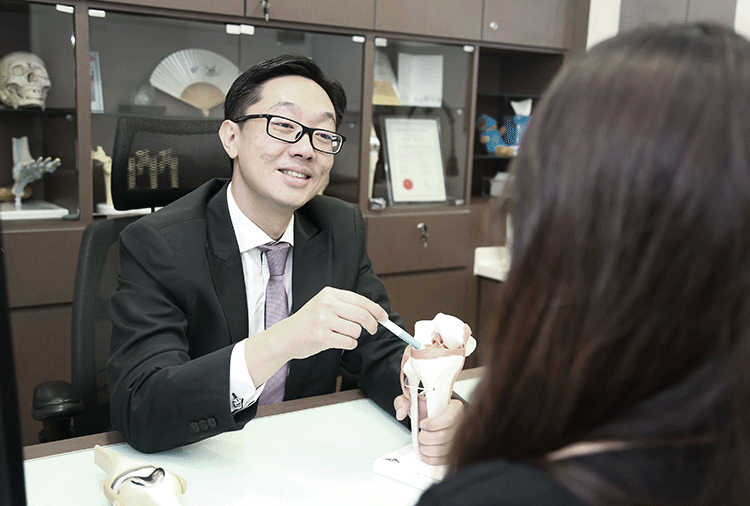Hip dysplasia is a condition that affects the stability and proper alignment of the hip joint, which can lead to pain and mobility issues. It is often detected in infants and children but can also present or persist into adulthood.
What Is Hip Dysplasia, And Why Is Treatment Important?
Hip dysplasia is a condition where the hip socket is abnormally shallow or misaligned, preventing the femoral head (the ball) from fitting snugly into the acetabulum (the socket). This improper fit can cause joint instability, pain, and an increased risk of osteoarthritis. Early treatment is important because it can prevent long-term joint damage and improve joint function.
For infants and children, treatment often involves bracing or surgery to correct the hip’s alignment. In adults, treatment may include physical therapy, pain management, or surgical interventions like hip preservation surgery or hip replacement. Addressing hip dysplasia promptly helps maintain mobility, reduce pain, and prevent the progression of joint damage.
What Are The Causes And Risk Factors Of Hip Dysplasia?
Causes
- Genetics – A family history of hip dysplasia can increase the likelihood of developing the condition.
- Birth Position – Babies born in a breech position (buttocks or feet first) are at higher risk for hip dysplasia due to the abnormal positioning in the womb.
- First-born Status – First-born children are more likely to have hip dysplasia, possibly due to the tighter uterine environment.
- Swaddling Practices – Incorrect swaddling techniques that keep the legs straight and together can contribute to hip dysplasia in infants.
- Intrauterine Position – Limited space in the womb, such as in multiple pregnancies, can increase the risk of hip dysplasia.
Risk Factors:
- Family History – A genetic predisposition to hip dysplasia can increase the risk.
- Gender – Females are more commonly affected by hip dysplasia than males.
- Birth Order – First-born children are at a higher risk.
- Breech Delivery – Babies delivered in a breech position have a higher incidence of hip dysplasia.
- Oligohydramnios – Low levels of amniotic fluid during pregnancy can restrict fetal movement and increase the risk.
- Large Birth Weight – Heavier babies are more prone to hip dysplasia due to the increased pressure on the hips during development.
- Cultural Practices – In cultures where infants are tightly swaddled with their legs extended, the incidence of hip dysplasia is higher.
What Are The Common Symptoms Of Hip Dysplasia?
Recognising the symptoms of hip dysplasia is essential for early intervention and effective treatment. This condition can lead to significant complications if left untreated, so awareness of its signs is crucial for timely medical attention.
- Hip Instability – A noticeable sign in infants where the hip joint feels loose or dislocated. This is often detected during routine physical exams.
- Limited Range of Motion – Difficulty in moving the leg outward from the hip, which can be observed during diaper changes.
- Uneven Leg Lengths – One leg may appear shorter than the other due to the misalignment of the hip joint.
- Asymmetrical Skin Folds – Uneven skin folds in the thigh or buttocks area can be a sign of hip dysplasia.
- Pain – Older children, adolescents, or adults with untreated hip dysplasia may experience hip pain, especially after physical activity.
- Limping – A limp or waddling gait can develop in children as they begin to walk, indicating hip instability.
- Clicking or Popping – Some individuals may hear or feel a clicking or popping sensation in the hip joint during movement.
How Is Hip Dysplasia Diagnosed?
Early and accurate diagnosis is crucial for managing the condition effectively and preventing long-term complications. The diagnostic process involves a thorough clinical examination and various diagnostic tests to evaluate the hip joint’s structure and function.
Clinical Examination
- Medical History – The doctor will review the patient’s medical history, including any symptoms, such as pain, difficulty walking, or instability, and any relevant family history of hip dysplasia.
- Visual Inspection – The hip will be examined for signs of asymmetry, swelling, or abnormal posture. The doctor will observe the patient’s gait and movement patterns.
- Physical Examination – The doctor will perform specific physical tests to assess the hip joint’s stability and function. This may include:
- Barlow Test – A test for infants to detect hip dislocation or instability by gently pushing the thigh backwards while applying pressure to the hip joint.
- Ortolani Test – A test for infants to detect hip reduction by gently abducting and rotating the thigh to feel for a “clunk” indicating that the hip has been relocated.
- Range of Motion Assessment – The doctor will evaluate the hip’s range of motion to identify any limitations or discomfort during movement.
- Gait Analysis – The doctor may observe the patient walking or performing specific movements to detect any irregularities or compensatory patterns.
Diagnostic Tests
- X-rays – X-rays are the primary imaging tool used to diagnose hip dysplasia. They provide clear images of the hip joint and can show abnormal joint alignment, shallow acetabulum, or signs of dislocation.
- MRI – Magnetic Resonance Imaging (MRI) offers detailed images of the soft tissues, including cartilage and ligaments. It is useful for assessing the extent of joint damage and any associated abnormalities.
- Ultrasound – Ultrasound imaging is particularly useful for infants and young children to visualise the hip joint’s soft tissues and detect early signs of dysplasia before bone changes occur.
- CT Scan – A Computed Tomography (CT) scan can provide detailed cross-sectional images of the hip joint and is used in complex cases to assess the bone structure and joint alignment.
What Are The Hip Dysplasia Treatment Options?
Hip dysplasia is a condition where the hip joint is not properly aligned, leading to potential dislocation or degeneration. Treatment focuses on managing symptoms, improving joint function, and preventing progression. Options vary based on age, severity, and individual needs, but generally include:
Lifestyle Modifications:
- Weight Management – Maintaining a healthy weight reduces stress on the hip joint and can alleviate symptoms.
- Activity Modification – Avoid activities that put excessive stress on the hip, and opt for low-impact exercises to minimise discomfort and prevent further damage.
Physical Therapy:
- Exercises – A physical therapist can design exercises to strengthen the muscles around the hip, improve joint stability, and enhance overall function.
- Stretching and Strengthening – Specific exercises can help maintain joint flexibility and support the hip joint.
Bracing and Orthotics:
- Hip Braces – For infants and young children with developmental dysplasia, a brace like the Pavlik harness may be used to keep the hip joint in the correct position and promote proper development.
- Orthotic Devices – In some cases, custom orthotic devices or shoe inserts can help improve joint alignment and reduce discomfort.
Medications:
- Pain Relievers – Over-the-counter NSAIDs (e.g., ibuprofen or naproxen) can help reduce pain and inflammation.
- Acetaminophen – Provides pain relief if NSAIDs are not suitable.
Injections:
- Corticosteroid Injections – Injecting corticosteroids into the hip joint can provide temporary relief from pain and inflammation.
Surgical Options:
- Hip Arthroscopy – A minimally invasive procedure using small incisions and a camera to examine and treat joint issues. This can be used to repair damaged cartilage or remove debris.
- Osteotomy – A surgical procedure to realign the hip joint and improve its position in the socket. This is usually considered for younger patients or those with specific types of dysplasia.
- Hip Replacement Surgery – For severe cases, where other treatments are ineffective, a hip replacement may be recommended. This involves replacing the damaged hip joint with an artificial one, which can significantly improve pain and function.
Alternative Therapies:
- Acupuncture – Some individuals find relief through acupuncture, which involves inserting thin needles into specific points on the body to alleviate pain and improve function.
- Massage Therapy – Therapeutic massage can help reduce muscle tension and improve circulation around the hip joint.
Prevention Strategies For Hip Dysplasia
With hip dysplasia, the hip socket does not fully cover the ball of the femur, can lead to hip dislocation and osteoarthritis if untreated. Prevention strategies for hip dysplasia focus on managing symptoms, improving joint function, and preventing further complications. Here are some strategies:
- For infants, regular pediatric check-ups can help detect hip dysplasia early. If diagnosed, treatment can prevent complications later in life.
- Engage in exercises that strengthen the muscles around the hip, such as the glutes, quadriceps, and hamstrings. Strong muscles provide better support and stability to the hip joint.
- Maintain flexibility in the hip and surrounding muscles to reduce tension and improve joint function. Include stretches for the hip flexors, hamstrings, and glutes.
- Wear shoes that provide adequate support and cushioning to reduce stress on the hip joints. Replace worn-out shoes regularly to maintain proper support.
- Minimise participation in high-impact sports or activities that put excessive stress on the hip joint. Focus on low-impact activities like swimming, cycling, or yoga.
- Make ergonomic adjustments at home and work to reduce stress on the hip joints. Use chairs with proper support, adjust the height of workstations, and use supportive cushions as needed.
- Maintain a healthy weight to reduce the stress on hip joints. A healthy diet and regular exercise can help achieve and maintain an optimal weight.
- Incorporate a variety of activities into your fitness routine to avoid overuse injuries. Cross-training can help balance muscle development and reduce repetitive strain on the hips.
- Educate yourself about hip dysplasia, including risk factors, symptoms, and treatment options. Awareness can lead to early detection and prompt treatment.
- Schedule regular check-ups with a healthcare professional to monitor hip health and address any underlying issues that may contribute to hip dysplasia. Early detection and intervention can help prevent progression and improve treatment outcomes.






